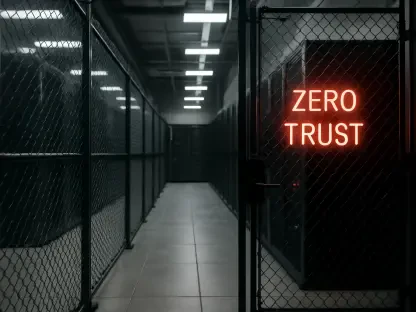What if the secret to revolutionizing network operations lies not in the latest technology, but in the hands of those guiding the strategy? In an era where businesses depend on seamless connectivity for hybrid work, cloud integration, and AI-driven processes, intelligent networks have become the backbone of success. Yet, countless organizations falter, not due to outdated systems, but because of leadership that fails to adapt. This feature dives deep into how transformational leadership can elevate network operations from mere infrastructure to a competitive edge.
The Critical Role of Leadership in Network Evolution
The stakes for network performance have never been higher. With digital transformation accelerating, networks must support dynamic demands while ensuring reliability and security. Leadership holds the key to navigating this complex landscape, bridging the gap between technical capabilities and business goals. Without visionary guidance, even the most advanced systems risk becoming underutilized or misaligned with organizational needs.
This story isn’t just about technology—it’s about the human element driving change. The shift from traditional, reactive management to proactive, strategic oversight can redefine how networks contribute to growth. As businesses face mounting pressure to innovate, the role of leaders in shaping intelligent network operations emerges as a make-or-break factor.
Navigating the Third Era of Networking
Today’s networking landscape, often termed the third era, is defined by automation, IoT expansion, and ever-shifting business requirements. Sticking to old-school, individual-centric management styles in this environment spells trouble. Networks are no longer just support systems; they are strategic assets that can set a company apart from competitors.
Leaders must pivot from solving isolated issues to cultivating collaborative, results-driven teams. The rise of network-as-a-service (NaaS) and managed services adds another layer of complexity, demanding a blend of technical insight and cultural adaptability. Embracing this sociotechnical challenge is essential for maintaining agility and staying ahead in a fast-evolving market.
Essential Leadership Qualities for Modern Networks
Transforming network operations hinges on specific leadership attributes tailored to today’s demands. Outcome-focused leadership stands out, prioritizing metrics like service delivery lead time and change success rate over mere activity counts. A real-world example shows that slashing delivery lead time by 60% without incidents delivers far greater value than simply logging numerous changes.
Another vital trait is lean management, which targets waste in processes—think unnecessary approvals or delays from manual errors. Studies reveal that 80% of deployment delays often stem from bureaucratic holdups rather than technical hurdles. Streamlining these inefficiencies can drastically boost performance.
Finally, team-centric leadership breaks down silos between network domains like LAN, WAN, and security. By forming cross-functional units focused on end-to-end outcomes, decisions become more holistic and effective. These qualities collectively empower teams to align network operations with broader business objectives.
Expert Perspectives on Leadership Impact
Research and industry voices paint a clear picture of leadership’s influence on network transformation. The DORA team’s findings in their book “Accelerate” emphasize that transformational leaders enhance performance by fostering environments where lean practices thrive. Though rooted in software development, these principles translate directly to network operations, highlighting the indirect yet profound impact of strong guidance.
McKinsey & Company’s studies further support this, showing that team-oriented transformations yield significant gains in efficiency and scalability. Chris Grundemann, Executive Advisor at Khadga Consulting, puts it succinctly: “The biggest hurdle in network transformation isn’t technical—it’s sociotechnical. Leaders must prioritize business outcomes over mere network management.” Such insights stress the urgency of cultural evolution alongside technological upgrades.
Practical Steps for Leadership Overhaul
Shifting to a modern leadership model in network operations requires actionable strategies. Start by defining outcome metrics—measure service delivery lead time, change success rate, and mean time to business impact. These indicators shift focus from tasks completed to value delivered, reframing how success is perceived.
Next, experiment in low-risk settings to test innovations like automation or process tweaks without endangering critical systems. Simultaneously, invest in building team capabilities through training in automation and cross-functional collaboration. Recognizing and rewarding outcome-driven behaviors while ensuring psychological safety—through clear rollback plans and blame-free learning—further embeds a progressive culture.
Empowering teams to make decisions within defined guidelines also cuts through bottlenecks, reserving escalation for high-risk scenarios. These steps, when executed thoughtfully, can transition leadership from outdated heroics to a sustainable, high-performance framework that meets third-era demands.
Reflecting on Leadership’s Lasting Influence
Looking back, the journey of transforming intelligent network operations through leadership revealed a fundamental truth: technology alone wasn’t the answer. The real breakthroughs came when leaders embraced outcome-focused mindsets, streamlined wasteful processes, and empowered collaborative teams. These shifts turned networks into true enablers of business success.
Moving forward, the challenge lies in sustaining this momentum. Organizations must continue to prioritize leadership development, ensuring that those at the helm are equipped to anticipate and adapt to emerging trends. By fostering a culture of continuous improvement and strategic alignment, the path toward resilient, intelligent networks becomes not just achievable, but a cornerstone of long-term growth.









